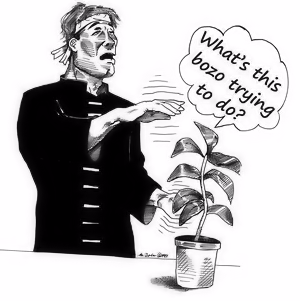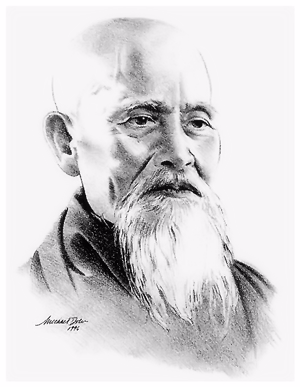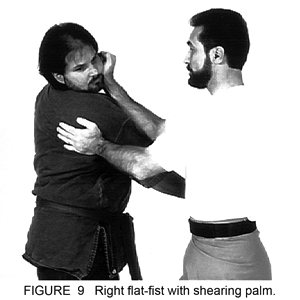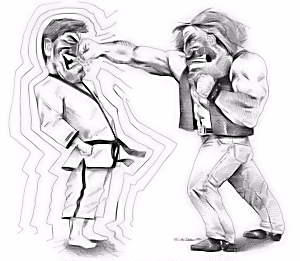
In a letter to the editor of Inside Kung-Fu magazine, W.Bentley Glass (1993, 6) commented, Although I have spent 20 years studying various styles of martial arts, both as a class student, and more recently through private instruction from an eighth-degree master, too much still escapes me. The myths of chi power, internal energy, and their application in self-defense abound. Countless articles are published on the subject, and everywhere there are experts making near-miraculous claims about the potential of chi and, of course, their ability to use this mysterious and elusive force. This chapter explores this metaphysical aspect of the art, subjecting to close scrutiny chi, chi power, and those who claim to have mastered it. Returning to reality, it concludes with practical definitions for this "invisible elusiveness" and applications of it that will help us better understand this highly speculative and abstract element of the art. Some seek instruction in chi-power generation because they want an easier way to thwart, repel, or overpower an assailant. We can understand their desire. The healthy and disciplined sixty-year-old martial artist quoted above, for example, is well aware of the limitations that the normal aging process forces on each of us. Cultivating chi power to offset this natural erosion seems a reasonable way to go. However, as this gentleman has found, such power is, at best, elusive, and at worst, illusive. Part of the difficulty in getting our arms around the subject is the paradoxical nature of the word itself. Chi is, simultaneously, a very concise and very nebulous term. Its seemingly contradictory linguistic nature means that chi is greatly misunderstood. Compounding this is the fact that there are some who, to advance various personal interests, misrepresent this mysterious force. Writing about chi, I am quite frankly tempted to immediately blaze away at those who deliberately lead us astray about chi and their ability to control or use it. However, if this study is to fare any better than those that have gone before, then I must resist this temptation and follow a more disciplined and logical course. To that end, the best place to begin is by identifying the primary source or root of chi in the martial arts.
Divisible By (At Least) ThreeDepending on how fine a line you wish to draw, you can divide Asian martial arts into many different categories. However, for our purposes, only three divisions are necessary:
Our last division – and the one we're most interested in – knifes across both of the preceding categories – striking and grappling, hard and soft. This division separates internal from external systems and is represented by the diagonal line running from the top-right corner to the bottom-left corner in figure 1. External and Internal Systems Although equally dedicated and vigorous in his training, the internalist spends much less time on toughening his hands and feet, and strenuously conditioning his muscles. Instead, he focuses on technical specifics and chi development. For example, an internalist trains continually to develop the optimal stance, precise weight distribution, proper timing, and best lines of force. This means that, among other things, his training regimen includes more slow practice routines than that of the externalist. Bringing all of these elements together perfectly is seen by the internalist as chi, or as the result of successful chi-power development. Which brings us to the focus of this chapter.
Holy Grail of the Martial ArtsChi or ki is central to the practice of aikido. The name, aikido comes from three words: ai, ki, and do. Ai means love, harmony, or unification. Do means way and, specifically, a spiritual path. (In Chinese, it is the word tao.) The second, and central word in all of this is ki. Ki means breath, awareness, and energy – energy that exists in man and throughout the universe. Aikido, then, is the "way of harmony with universal energy." It is said that "the understanding of this original and universal energy plays an essential and primordial part in aikido, in the form of ki" and that "Aikido is defined by the way it relates man to the cosmic power, or ki" (Random 1992, 206).Chi is pivotal to China's internal arts as well. Among the Chinese arts, external systems are those whose roots trace back to one of the ancient Shaolin temples. Internal systems, on the other hand, grow from Taoist traditions (note their placement in figure 1), and it is here that our problems with chi begin. Taoism (pronounced dao'izm) is a Chinese mystical philosophy. Accepted traditionally as founded by Lao-Tzu sometime between the sixth and fourth centuries BC, Taoism teaches conformity to the tao (the way) by unassertive action and simplicity. As a religion, Taoism is often regarded as a corruption of Taoist philosophy. In its evolution from Buddhist-influenced philosophy, the Taoist religion began with the addition of the practice of alchemy: the mixing of elixirs that were intended to ensure immortality. Taoist priest-magicians were acclaimed as spirit mediums and experts in levitation. Among the prominent features of Taoist religion are belief in physical immortality, alchemy, breath control, and a pantheon of deities. As a philosophy-religion, Taoism focuses on obtaining long life and good fortune, frequently by magical means. Magic, then, is the root of chi and chi power. Magic
Autosuggestive effects are hard to prove, and no one wants to embarrass the individuals involved, but chi claimants need to be challenged. In no other discipline are practitioners allowed to present purely subjective "feelings" as fact, without offering some way of objectively verifying them. However, in the martial arts, this happens over and over again. Those claiming to possess chi get away with making unsubstantiated claims without once having to prove them. Take the case of chi "masters" who claim to be able to repel individuals using nothing but chi – no tricks, no physical contact – only chi energy. (This example is cited because it occurs most frequently and because of its potential application in self-defense.)
If these chi practitioners actually possess this illusive force, they seem not to have mastered it, for they are unable to control it beyond either full "on" and "off" (except, again, with their own students). This is like the used car salesman saying, "This Ferrari is capable of zero or 200 miles per hour, but not 15, 30, or anything in between." The exotic chi racer, it seems, can run you down, but it cannot be parked! Curiously, most of us can control our external, inanimate, several-thousand-pound motor vehicles with greater precision than chi masters can control their own internal power. Chi may be an elusive force, but based on some of the excuses given for not submitting it to verifiable tests, it is downright slippery. I admit that all of the; chi charlatans have left me more than a little skeptical, but I am not the only one. One respected t'ai chi player with more than a score of years in the art (t'ai chi, like aikido, is an art that directs and utilizes chi in its training and application), hit the nail on the head when he said, During most of my tenure as a martial artist, qi has been represented to me as a 'Life Force' which, in a magnificent nose-thumbing way, was immeasurable to that poor sap, the Western scientist (Sigman 1992, 6).In describing the exercises that develop this "Life Force," he went on to say that, Whatever 'qi' was, qigongs were ritualistic exercises which were reputed to develop it. In other words, qigongs developed the unexplainable in unexplained ways.Electromagnetic Force? The smoke and mirror, magical descriptions chi claimants foist on us sound strangely similar to early scientific descriptions of electricity. For the longest time, an accurate definition of electricity eluded us. Even today, a definition that the layman can fathom is beyond most of us. However, as unexplainable as electricity was, we at least understood its laws. We knew, for example, how to generate it, how to store it, and how to put it to useful work. We knew very well (and in some very concrete, explainable, and reproducible ways) how to use electricity. Even a child could control its flow and harness its power with just one tiny finger. And all of this was possible before we could accurately explain exactly what it was. The same is true for magnetism. Long before men knew exactly what it was, they knew how to use it. Moreover, the needle pointing north worked for everyone who tried it. Chi's parallel with electricity and electromagnetic force is not new. More than a few have described chi as along these lines. The major difference, however, is that the effects and properties of electricity and electromagnetic force are known, reproducible, and verifiable. The effects and properties of chi – so far anyway – are not. The physical capabilities and theories of Asian fighting arts have been tested repeatedly and proven to work. Noncontact chi power, on the other hand, has not. It is magic; nothing more. But rejecting noncontact chi as magic still leaves us with a problem. How do we explain the almost supernatural feats performed by some highly credible martial art masters – feats that appear well beyond the individual's physical capabilities? I'm not talking about the ability to break flaming boards, tall stacks of bricks, or slabs of ice – those are merely side show tricks designed to attract customers. What I am talking about are the incredible skills and abilities legitimate masters of the art often possess.
Chi Descriptions – From Allegorical To LiteralApart from the outlandish claims of chi charlatans, I think that the problem is not one of whether or not individuals use chi, but one of correctly understanding what the chi they use really is. Consider the following Eastern description of a blow as it is delivered with chi: Pulling or borrowing chi from the earth, you channel this energy through your foot and leg, to the tan tien [the body's chi center], finally releasing it through your arm and to your opponent.Describing the same action in Western terms, and you get something like this: Starting from a solid base and beginning with the foot, the calf and thigh muscles contract. Simultaneously, the hip rotates and sinks into the movement adding mass to the acceleration of the arm as it is thrust forward, striking the target. The Eastern description of the punching process – "borrowing chi from the earth" – is allegorical. It represents a physical process in abstract, almost spiritual, terms. The Western description, on the other hand, is (to our thinking) literal. For us, the same punching process is simply the neuro-muscular sequence of material events necessary to deliver a single punch or blow with staggering, almost unbelievable power. However, the phrases "physical process" and "material events," although accurate, lead us to the narrowest conception of what chi really is. Even devoid of its magical connotations, chi is still more than a purely physical process or event. Synergy
Taken together, the five elements listed add up to ten. However, applied cooperatively, that is, synergistically, their collective effort may be many times greater than the sum of the individual elements.1 This is what Ed Parker meant when he described chi as follows in his Infinite Insights into Kenpo, Volume One (1982, vii). . . . the state of the body and mind where one obtains the maximum force of his body. It involves total and complete synchronization of mind, breath, and strength to achieve maximum focus. It is that extra inner force created by the precise synchronization of mind, breath, and strength. "Synchronization" is the operative word here. I believe that synchronization is what Miyamoto Musashi, the most famous of Japan's swordsmen, referred to when he said that "There is timing in everything. Timing in strategy cannot be mastered without a great deal of practice." Synergy or Chi cannot happen without timing, and timing is – as Parker put it, "complete synchronization of mind, breath, and strength." Combining Parker's definition with Musashi's remarks about timing and the practice necessary to develop it, and chi becomes something that flows from the mental imprint of a well-practiced technique or movement. When required, the mind follows this imprint instinctively, flowing with singleness of purpose, calmness of mind, and a complete coordination between mental and physical that is practically unstoppable. This chi, this synergy, then, is a precise moment in time when the mind, will, and emotions are in complete and total harmony with an adrenaline-charged body. In that instant, the fighter, by virtue of bringing all of the mental and physical elements together perfectly, performs at a level that extends well beyond his observable physical abilities. Thus far, in our effort to understand chi we have examined its Taoist origins, removed its magic, found a comparable and equally concise Western word for its practical aspect, and compiled a logical definition of this "invisible elusiveness." But to see how chi manifests itself in actual application we need to change our perspective from the practitioner and his training, to one that focuses on the effects. What happens when this synergy or chi comes together in a self-defense technique?. Let's take two movements (remember, movements are parts of techniques) and see how external application might differ from an internal one. We'll begin with an externalist's defense against a right punch. External and Internal Application 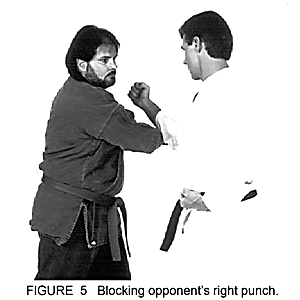 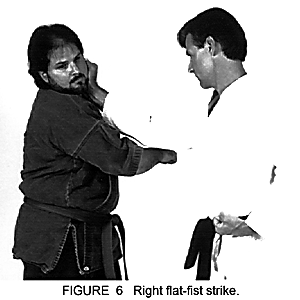
A similar defense by an internalist also begins with a right arm redirecting the assailant's blow (figure 7). Instead of the flat-fist, though, the internalist's counterattack is a right palm strike to the left side of the attacker's face (figure 8). This may look like an inferior blow, but it is not, for the right palm is only half of the movement. Simultaneous with the right palm strike, the internalist's left hand slaps the back of his assailant's right shoulder. This effectively (and painfully) twists the attacker's neck by rotating his head clockwise (with the right hand) while, simultaneously, thrusting his shoulder in the opposite direction (with the left hand). 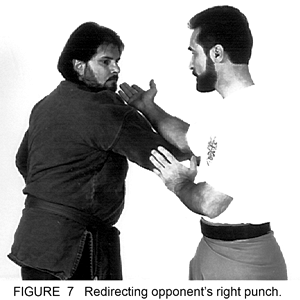 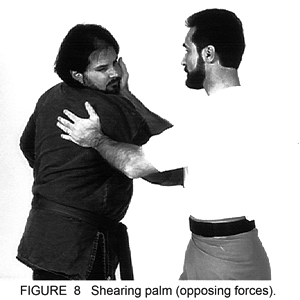
This defensive movement is clearly not as head-rattling as the preceding one. The assailant's jaw is neither distended nor swollen. However, his incapacitation is just as immediate and just as effective. Instead of a broken jaw, the opponent suffers severe neck trauma. By timing his right palm to the face with the simultaneous left palm strike to the back of the attacker's shoulder, the defender forces the assailant's head to rotate well past its normal limit, resulting in potential cervical disc, vertebrae, or ligament damage. (Having had neck surgery myself, I can personally vouch for just how painful and disabling a neck injury can be.) Although incapable of probing the depths of difference that exist between internal and external fighting methods, these two very simple examples clearly show that internal techniques require a significantly higher level of sophistication than do similar techniques from most external systems. This is because more elements must come together at precisely the right instant to produce their disabling effect (again, synergy). The effectiveness of bringing together many elements is obvious when comparing two tried-and-true weapons, the war club and the modern semiautomatic handgun. Both the war club and the modern handgun have proven themselves in combat. When it comes to self-defense, a baseball bat (the modern equivalent of a war club) is a very potent weapon. It has no moving parts to malfunction, and it requires minimal skill to wield effectively – two very strong points in its favor. On the other hand, the .45-caliber semiautomatic handgun has many moving parts, any number of which are much more vulnerable to damage than the ball bat. Moreover, considerably greater skill is necessary to master the handgun. Compared to the bat, then, these differences would seem to make the handgun less desirable than the bat. Still, in a life-threatening situation, I think it is fair to say that most of us would much rather have the handgun. Lest we think that one system is necessarily better than the other, remember that both methods, although fundamentally different, are still very effective. External arts are, I believe, better suited to younger practitioners. Conversely, internal systems are more beneficial for practitioners with decades of training under their belts. I say this because "mature" practitioners – by virtue of their many years of practice – possess the higher skill level and precision necessary to make internal techniques work. That said, let me quickly add that we benefit most when we recognize the value in both systems.
Some Key PointsThe human mind is capable of incredible things. Its potential is not even remotely understood, much less used. Doubtless, the body possesses and generates energy. Thermographs show that we radiate heat energy. Electroencephalographs record electrical activity in the brain. These are two known and verifiable energies we possess. Two hundred years ago these things were unknown, and the prevalent theories of that day have, for the most part, been completely disproved or replaced by others. Who then, is to say that 200 years from now, our theories will not suffer the same fate? From that perspective, I leave myself cautiously open to the possibility of another, still unknown, energy source within. I say "cautiously open," because whatever energy source or inner power is discovered, it must be verifiable, reproducible, and stand up to close scientific scrutiny. Until then, I see nothing but danger in the unquestioned acceptance of some mystical power in martial art practice.
As a viable part of the martial artist's arsenal, chi, and specifically noncontact chi, is dubious, at best – at least as long as its proponents continue babble definitions that defy understanding and claim examples of its power that remain clearly in the unproven realm of folklore. Until proof is presented – not "more" proof, for we have none, as yet – we will have to settle for a chi that is a synergistic, near-perfect union of mind, body, and spirit for the accomplishment of a specific task – which in our case is effective self-defense. This kind of logical definition removes the shroud of mystery from the elusive chi and strips it of its undeserved "metaphysical" label. Ed Parker (1982, 3) summed it up beautifully when he said, "It must be remembered that whenever a subject develops definable qualities, when the unknown becomes known, the mysticism disappears. Martial arts are a real and tangible subject." A real and tangible definition of chi actually facilitates sound martial art study, for it makes the student work as much on perfecting his technique as he does on his physical conditioning. The axiom "perfect technique comes from perfect practice" is as true today as it ever was. Chi or no, there is still no shortcut to real martial skill. |
|
Footnotes:
|
|
©Copyright Bob Orlando, 1993-2016 All rights reserved. |
http://www.OrlandoKuntao.com
E-mail: ron@orlandokuntao.net |
Last update:
Aug. 6, 2016 by Bob Orlando |



